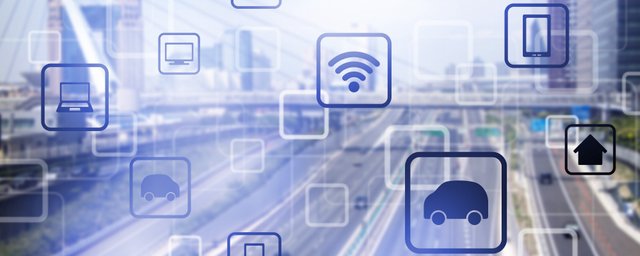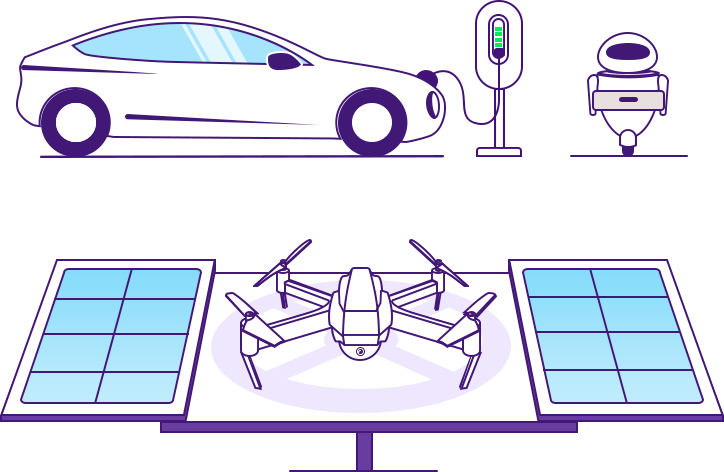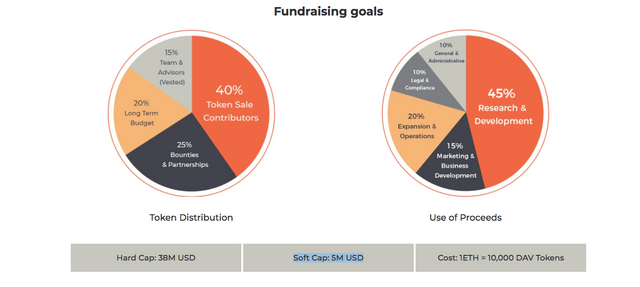DAV is a blockchain-based transportation platform
_(1).jpg)
Currently, it is hard to imagine that in our everyday life autonomous vehicles, such as drones, self-driving cars, trucks, and even boats will be actively used. It's more like shots of the movie, than reality. But technological progress doesn't stand still, including also the transport sector actively develops. Commercialization of autonomous vehicles is well underway: the sphere of their application extends, technologies become more functional and more available including for ordinary people.
Development of telecommunications and emergence of new standards of communication offers big prospects of them useful for different spheres of the economy: from delivery of small loads and photo and video filming before the patrol of streets and implementation of observation for different researchers.
Imagine, how it might revolutionize the domain of delivery. For example, for the operational delivery of necessary medicines or the equipment to zones of natural disaster, or just to hard reach areas: the to autonomous vehicles doesn't need to get stuck in traffic jams or to look for detour routes. With their help, it is possible to order delivery of food, goods, documents, parcels, from anywhere wherever you are, even on your yacht in the sea.
Using of autonomous vehicles is help easily to find the center of the wildfire or the careless fisherman who is carried away on an ice floe down the river. Rescue services can patrol district, to monitor for animals and to look for lost travelers.

In the future autonomous vehicles will become the mass phenomenon, and also the integral part of human life. But on the way to an era of entirely of autonomous vehicles remain to be resolved the mass of problems. The stack of DAV technologies which will make this ecosystem a reality is at the moment created, providing close cooperation between autonomous vehicles, service providers, and users.
For the efficient and fast transition from the existing transport system to the autonomous, has to be created the vast network of support. Is autonomous network must include many autonomous vehicles widespread in all target areas. Many parking spaces have to equipped with specialized parking spaces for autonomous vehicles. Now many large corporations experiment with autonomous vehicle fleets, for example, Domino - testing the robots for pizza delivery, Amazon Prime Air the robot planes, Waymo the autonomous taxi, and Baidu the automated vehicles with open source code. But it should be noted that those companies, pursue only own narrow interests which focus on dominating own of the isolated networks, not on the creation of more efficient and more various options of use in the long term. The lack of incentives for cooperation interferes with rates of progress in this sector.

The DAV open platform with open source code will provide economic incentives for participation of many users because it will be comprehensive and free. It will allow increasing growth rates considerably and scaling this sector. The DAV will provide cooperation for new players who will be able to enter the market and to take part in transport economy. The decentralized network with an open source code means that players can independently take measures in response to the blank, or poorly filled requirements of the market.
Thanks to the open search of a stack of technologies and decentralization of protocols around identification, detection, a flow of the missions and payments provided via the modular interface, DAV will make a revolution in the sector of autonomous vehicles.
The stack of DAV consists of five main decentralized components, each of which is necessary for the creation of an autonomous ecosystem of vehicles.
1. Identity
Each entity using the DAV network will have own identification - DAV Identity. Anyone which wants to get transport services, a charging station for unmanned aerial vehicles, the car without the driver, insurance service or even group of several cargo unmanned aerial vehicles managed by one system can become such entity.
DAV identities are stored and traced in a decentralized way in a blockchain and can be processed only through the set interface. This interface provides strict control of access to the one who or what can manipulate and use each identity.
Each identity comprises it a ledger in which in detail describe the history of the carried-out transactions and also their result. It gives the management of access based on permission, allowing any to get access to the full history transactions of each Identity at the same time strictly limiting write permissions. Estimating results of transactions of Identity over time will be making an accurate image of its authenticity and level of risk each party assumes in the transaction.
2. Discovery
One of the vital DAV functions is the ability of autonomous vehicles to find each other and also service providers and clients around them. Such detection also represents the structure of support necessary for example for the search of stations of charging, service and the parking.
The DAV implements this decentralized detection using P2P the protocol based on Kademlia DHT (P. Maymounkov and D. Mazières. Kademlia: A Peer-to-Peer Information System Based on the XOR Metric. New York University, March 2002.) It represents the same algorithm used by detection of the Ethereum nodes and also popular P2P protocols, such as BitTorrent. This protocol provides data transmission of general purpose and the interface for the interaction of applications through the P2P network. It is in the center of decentralization of DAV and also allows carrying out the decentralized communication.
The flexibility of DAV will allow the existing companies, to use opportunities, such as management of trips and management of own network of autonomous vehicles from the personal application. The service of detection which includes only charging stations which were checked by the third party solely for the use of renewable energy resources can be another example.
3. Communication
For communication with all surrounding objects the first decentralized communication, allowing autonomous vehicles to exchange data with other objects is developed for communication. Such communication is the primary element the to simplification of the majority of types of operations in DAV network and separated into two groups: communication on-blockchain and communication off-blockchain (P2P communication).
4. Mission Flow
To provide the fruitful exchange of services between two or several parties, DAV offers the protocol of communication intended for simplification of each step of a flow of a mission - from the initial statement for need tender, the performance of services and before final payment.
These steps are carried out by off-blockchain with use of P2P and are also regulated and applied by several a smart contracts for a blockchain.
The first step is a necessity. The buyer determines the need and creates a request for the service.
The second step is the bid (the bidding process). The seller responds to the application to perform the service for the buyer.
The third step is the signing of the contract. After the buyer receives several offers and makes a decision based on these tender proposals, between the parties will be signed a smart contract. DAV smart contracts support the transfer of DAV tokens after the successful completion of the mission.
The fourth step (optional) is communication within the mission. This function for to send data and status messages, which allows you to communicate buyers and sellers directly.
The fifth step is the resolution of the contract. After successful completion of the mission, both parties send a message to the contract indicating their satisfaction, followed immediately by the release of funds from the contract to the seller.
5. Payments for the services provided in DAV network
The decentralized payments of DAV are the main component of the DAV stack, which provides secure, carefree transactions between participants of DAV network. However, DAV tokens can only be used to pay for services provided in the DAV network.
DAV is committed to the success of its platform, as well as to the success of the economy and its participants, who support and develop the new generation of autonomous vehicles and infrastructure. The DAV team consists of successful entrepreneurs, innovators, experts on blockchain and specializes in autonomous transport. The team together with its consultants, partners, and community brings together the future of cooperation.
The purpose of the DAV utility token is in stimulating the creation of the autonomous transport infrastructure created by the community and building the platform an autonomous vehicle, which is commercially viable and open for cooperation.
Token sale 30 April, 2018 to 14 May, 2018.

Website - https://dav.network/
Whitepaper - https://dav.network/whitepaper.pdf
BitcoinTalk ANN - https://bitcointalk.org/index.php?topic=2614017.0
BitcoinTalk Bounty - https://bitcointalk.org/index.php?topic=2619886.0
Facebook - https://www.facebook.com/DAVNetworkTeam
Twitter - https://twitter.com/DavNetwork
Telegram - https://t.me/DAVNetwork